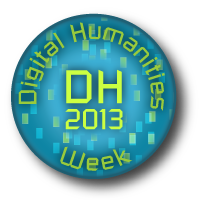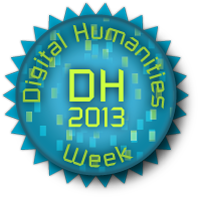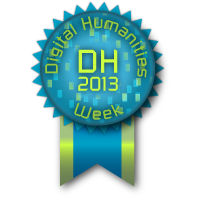The New Media Just-in-time Learning Initiative
Apart from its distinguished speakers and participant-driven THATCamps, the 2013 Digital Humanities Week features the launch of an extraordinary collection of online tutorials. A initiative sponsored by the New Media Department Correll Fund, this collection includes such digital humanities skills as how to design and code Web sites, how to mount digital exhibitions, and how to promote projects with social media.
Powered by a system developed by Still Water researchers John Bell and Jon Ippolito, these screencasts require their viewers to pass quizzes to reach the end, whereupon they are awarded digital badges corresponding to the skill taught in the tutorial. The badges are authenticated by Mozilla Backpack, which verifies publicly who has earned which badges.
Tutorials at the conference
The organizers of Digital Humanities Week are encouraging participants to create their own tutorials during the THATCamp portions of the conference. These will serve as a tangible product of the week’s discussions whose educational value will live long beyond the conference itself.
THATCampers can work with each other to produce one of these levels of a tutorial:
Level 1: Script

This is a written text of “how-to” instructions that can serve as the basis for a future screencast. It can take the form of a film script or just an outline.
Level 2: Screencast

This is a video capture of your screen, and may incorporate live video and other enhancements as described in How to make a good screencast. The video should show why and how to accomplish the task, including any pitfalls to avoid. THATCampers will have access to ScreenFlow software for making screencasts, and can access any of the nearby screens using an Airplay-enabled device (such as a recent Mac laptop or iPad).
Level 3: Interactive tutorial

The highest level of tutorial is a screencast enhanced with a badge design and interactive quizzes encoded in JSON, as described in How to make an interactive tutorial. New Media faculty will be on hand to help THATCampers produce these sophisticated tutorials.
Publishing your tutorial
At the conference’s end, you’ll be invited to submit your tutorial for publication in the free online system. The organizers will give you more details at the conference.
After you submit the tutorial, you’ll receive reviews from other participants via the Tutorial Pool, which may suggest ways to improve it. If your tutorial passes muster, it will be approved to enter the free online collection administered by the New Media Department.
As a bonus, every participant who submits a tutorial will automatically earn the appropriate level of the DH 2013 badge (shown above).
Related resources
You may want to review these before the conference:

 Anne Collins Goodyear (Co-director, Bowdoin Art Museum) is former curator at the Smithsonian's American Art Museum. As president of the College Art Association she presided over its first THATCamp in 2013.
Anne Collins Goodyear (Co-director, Bowdoin Art Museum) is former curator at the Smithsonian's American Art Museum. As president of the College Art Association she presided over its first THATCamp in 2013. Ari Epstein (Terrascope, Civil and Environmental Engineering, MIT) devises innovative settings for project-based, team-oriented education, from youth radio to exhibition design.
Ari Epstein (Terrascope, Civil and Environmental Engineering, MIT) devises innovative settings for project-based, team-oriented education, from youth radio to exhibition design. Nicole Starosielski (Media, Culture, and Communication, NYU) focuses on the global distribution of digital media, most recently on how transoceanic cables from telegraph to Internet have affected the geopolitics of islands and coasts. Her new media project Surfacing inspired the conference's title.
Nicole Starosielski (Media, Culture, and Communication, NYU) focuses on the global distribution of digital media, most recently on how transoceanic cables from telegraph to Internet have affected the geopolitics of islands and coasts. Her new media project Surfacing inspired the conference's title. Andrew Stauffer (Department of English, University of Virginia) is renowned as a digital historian of 19th-century literature and for his leadership of NINES (Networked Infrastructure for Nineteenth-Century Electronic Scholarship).
Andrew Stauffer (Department of English, University of Virginia) is renowned as a digital historian of 19th-century literature and for his leadership of NINES (Networked Infrastructure for Nineteenth-Century Electronic Scholarship).


